Analysis of Rising Suicide Rates in the United States: A Report
VerifiedAdded on 2023/01/19
|7
|1483
|66
Report
AI Summary
This report provides an overview of the increasing suicide rates in the United States, highlighting it as a significant public health concern. The report examines the alarming statistics, including the rise in suicide cases since 1999 and the impact on various age groups and demographics. It explores potential risk factors such as mental health issues, substance abuse, financial stress, and social isolation. The report delves into the warning signs of suicidal behavior, including changes in mood, withdrawal from social activities, and expressions of hopelessness. Furthermore, it discusses community and state-based solutions, emphasizing the need for prevention policies, public education, and access to mental health services. The report concludes with recommendations for further research and data collection to improve suicide prevention efforts. The report references various sources, including WHO reports, news articles, and published journals, to support its findings and recommendations.

Running head: SUICIDE
Student name
Student No
Unit
Title: Increase in Suicide Cases
Student name
Student No
Unit
Title: Increase in Suicide Cases
Paraphrase This Document
Need a fresh take? Get an instant paraphrase of this document with our AI Paraphraser
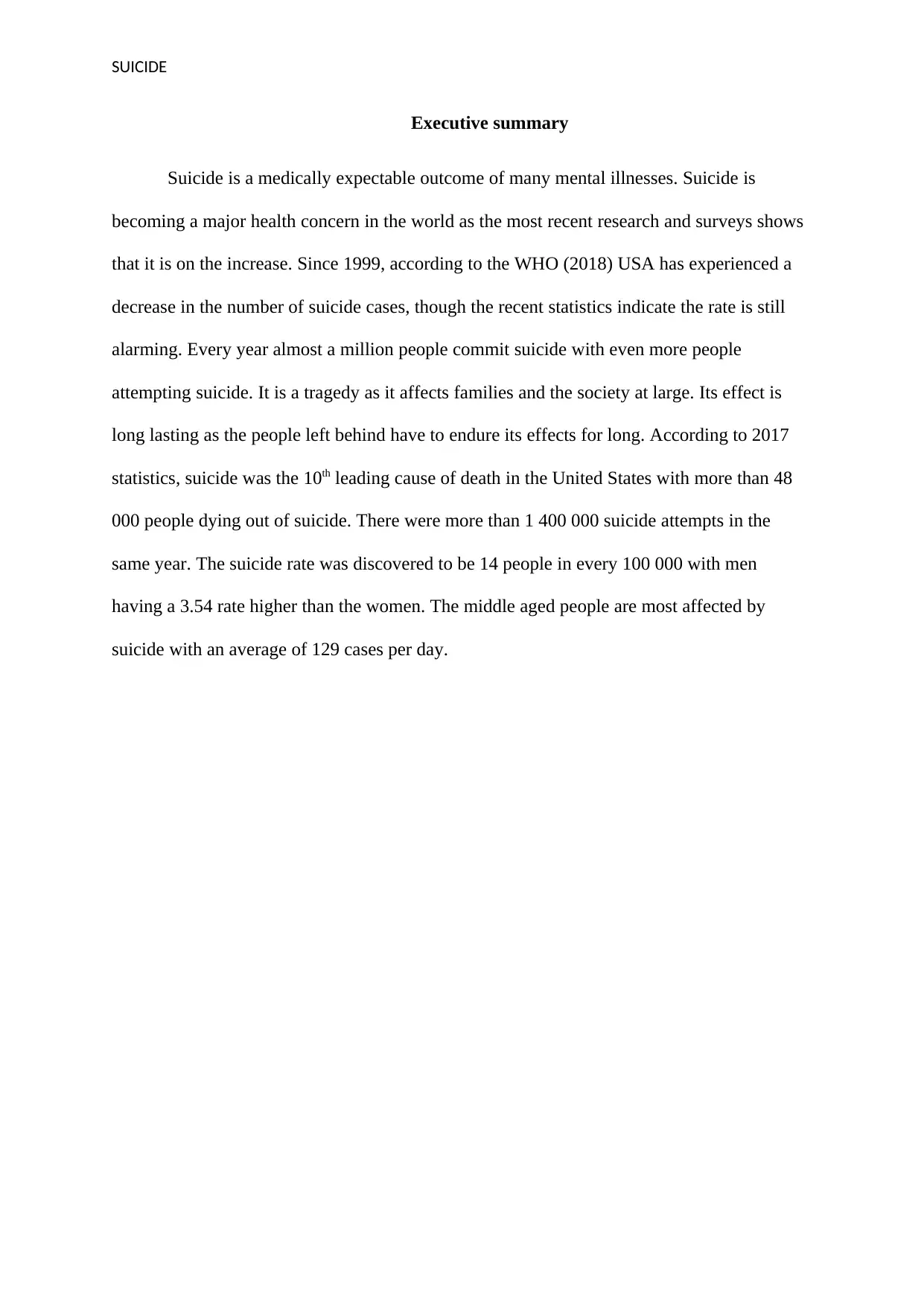
SUICIDE
Executive summary
Suicide is a medically expectable outcome of many mental illnesses. Suicide is
becoming a major health concern in the world as the most recent research and surveys shows
that it is on the increase. Since 1999, according to the WHO (2018) USA has experienced a
decrease in the number of suicide cases, though the recent statistics indicate the rate is still
alarming. Every year almost a million people commit suicide with even more people
attempting suicide. It is a tragedy as it affects families and the society at large. Its effect is
long lasting as the people left behind have to endure its effects for long. According to 2017
statistics, suicide was the 10th leading cause of death in the United States with more than 48
000 people dying out of suicide. There were more than 1 400 000 suicide attempts in the
same year. The suicide rate was discovered to be 14 people in every 100 000 with men
having a 3.54 rate higher than the women. The middle aged people are most affected by
suicide with an average of 129 cases per day.
Executive summary
Suicide is a medically expectable outcome of many mental illnesses. Suicide is
becoming a major health concern in the world as the most recent research and surveys shows
that it is on the increase. Since 1999, according to the WHO (2018) USA has experienced a
decrease in the number of suicide cases, though the recent statistics indicate the rate is still
alarming. Every year almost a million people commit suicide with even more people
attempting suicide. It is a tragedy as it affects families and the society at large. Its effect is
long lasting as the people left behind have to endure its effects for long. According to 2017
statistics, suicide was the 10th leading cause of death in the United States with more than 48
000 people dying out of suicide. There were more than 1 400 000 suicide attempts in the
same year. The suicide rate was discovered to be 14 people in every 100 000 with men
having a 3.54 rate higher than the women. The middle aged people are most affected by
suicide with an average of 129 cases per day.
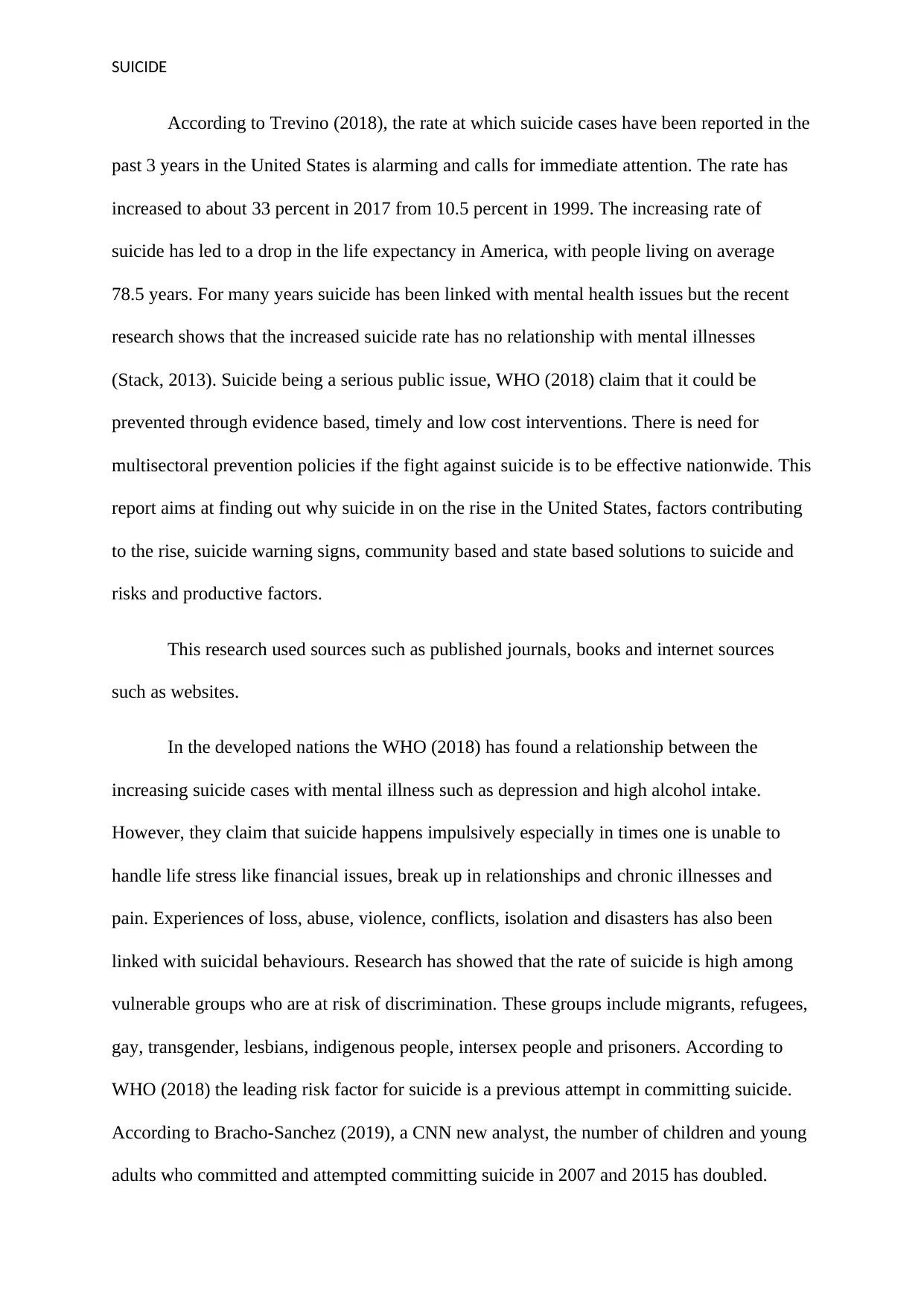
SUICIDE
According to Trevino (2018), the rate at which suicide cases have been reported in the
past 3 years in the United States is alarming and calls for immediate attention. The rate has
increased to about 33 percent in 2017 from 10.5 percent in 1999. The increasing rate of
suicide has led to a drop in the life expectancy in America, with people living on average
78.5 years. For many years suicide has been linked with mental health issues but the recent
research shows that the increased suicide rate has no relationship with mental illnesses
(Stack, 2013). Suicide being a serious public issue, WHO (2018) claim that it could be
prevented through evidence based, timely and low cost interventions. There is need for
multisectoral prevention policies if the fight against suicide is to be effective nationwide. This
report aims at finding out why suicide in on the rise in the United States, factors contributing
to the rise, suicide warning signs, community based and state based solutions to suicide and
risks and productive factors.
This research used sources such as published journals, books and internet sources
such as websites.
In the developed nations the WHO (2018) has found a relationship between the
increasing suicide cases with mental illness such as depression and high alcohol intake.
However, they claim that suicide happens impulsively especially in times one is unable to
handle life stress like financial issues, break up in relationships and chronic illnesses and
pain. Experiences of loss, abuse, violence, conflicts, isolation and disasters has also been
linked with suicidal behaviours. Research has showed that the rate of suicide is high among
vulnerable groups who are at risk of discrimination. These groups include migrants, refugees,
gay, transgender, lesbians, indigenous people, intersex people and prisoners. According to
WHO (2018) the leading risk factor for suicide is a previous attempt in committing suicide.
According to Bracho-Sanchez (2019), a CNN new analyst, the number of children and young
adults who committed and attempted committing suicide in 2007 and 2015 has doubled.
According to Trevino (2018), the rate at which suicide cases have been reported in the
past 3 years in the United States is alarming and calls for immediate attention. The rate has
increased to about 33 percent in 2017 from 10.5 percent in 1999. The increasing rate of
suicide has led to a drop in the life expectancy in America, with people living on average
78.5 years. For many years suicide has been linked with mental health issues but the recent
research shows that the increased suicide rate has no relationship with mental illnesses
(Stack, 2013). Suicide being a serious public issue, WHO (2018) claim that it could be
prevented through evidence based, timely and low cost interventions. There is need for
multisectoral prevention policies if the fight against suicide is to be effective nationwide. This
report aims at finding out why suicide in on the rise in the United States, factors contributing
to the rise, suicide warning signs, community based and state based solutions to suicide and
risks and productive factors.
This research used sources such as published journals, books and internet sources
such as websites.
In the developed nations the WHO (2018) has found a relationship between the
increasing suicide cases with mental illness such as depression and high alcohol intake.
However, they claim that suicide happens impulsively especially in times one is unable to
handle life stress like financial issues, break up in relationships and chronic illnesses and
pain. Experiences of loss, abuse, violence, conflicts, isolation and disasters has also been
linked with suicidal behaviours. Research has showed that the rate of suicide is high among
vulnerable groups who are at risk of discrimination. These groups include migrants, refugees,
gay, transgender, lesbians, indigenous people, intersex people and prisoners. According to
WHO (2018) the leading risk factor for suicide is a previous attempt in committing suicide.
According to Bracho-Sanchez (2019), a CNN new analyst, the number of children and young
adults who committed and attempted committing suicide in 2007 and 2015 has doubled.
⊘ This is a preview!⊘
Do you want full access?
Subscribe today to unlock all pages.

Trusted by 1+ million students worldwide
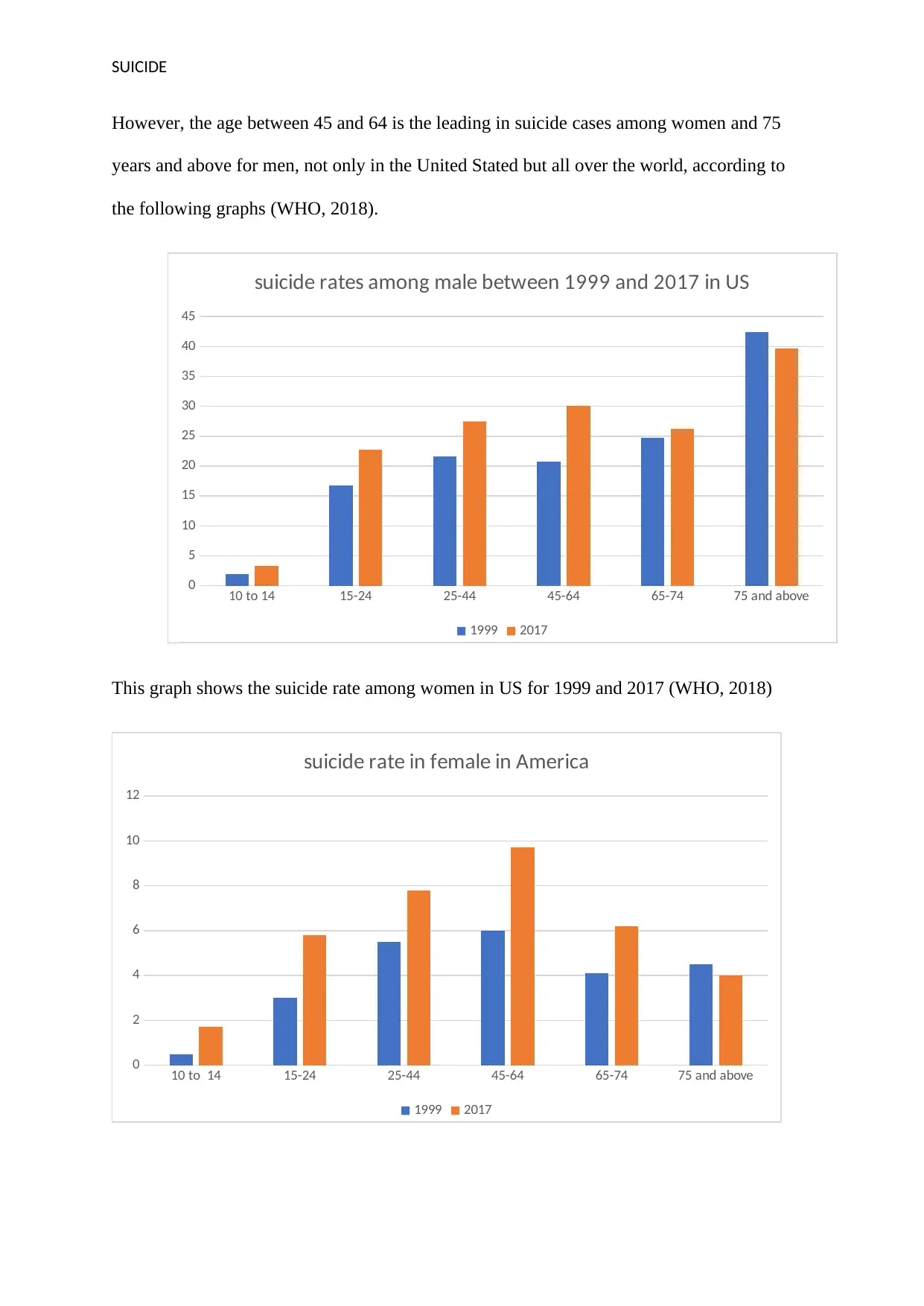
SUICIDE
However, the age between 45 and 64 is the leading in suicide cases among women and 75
years and above for men, not only in the United Stated but all over the world, according to
the following graphs (WHO, 2018).
10 to 14 15-24 25-44 45-64 65-74 75 and above
0
5
10
15
20
25
30
35
40
45
suicide rates among male between 1999 and 2017 in US
1999 2017
This graph shows the suicide rate among women in US for 1999 and 2017 (WHO, 2018)
10 to 14 15-24 25-44 45-64 65-74 75 and above
0
2
4
6
8
10
12
suicide rate in female in America
1999 2017
However, the age between 45 and 64 is the leading in suicide cases among women and 75
years and above for men, not only in the United Stated but all over the world, according to
the following graphs (WHO, 2018).
10 to 14 15-24 25-44 45-64 65-74 75 and above
0
5
10
15
20
25
30
35
40
45
suicide rates among male between 1999 and 2017 in US
1999 2017
This graph shows the suicide rate among women in US for 1999 and 2017 (WHO, 2018)
10 to 14 15-24 25-44 45-64 65-74 75 and above
0
2
4
6
8
10
12
suicide rate in female in America
1999 2017
Paraphrase This Document
Need a fresh take? Get an instant paraphrase of this document with our AI Paraphraser
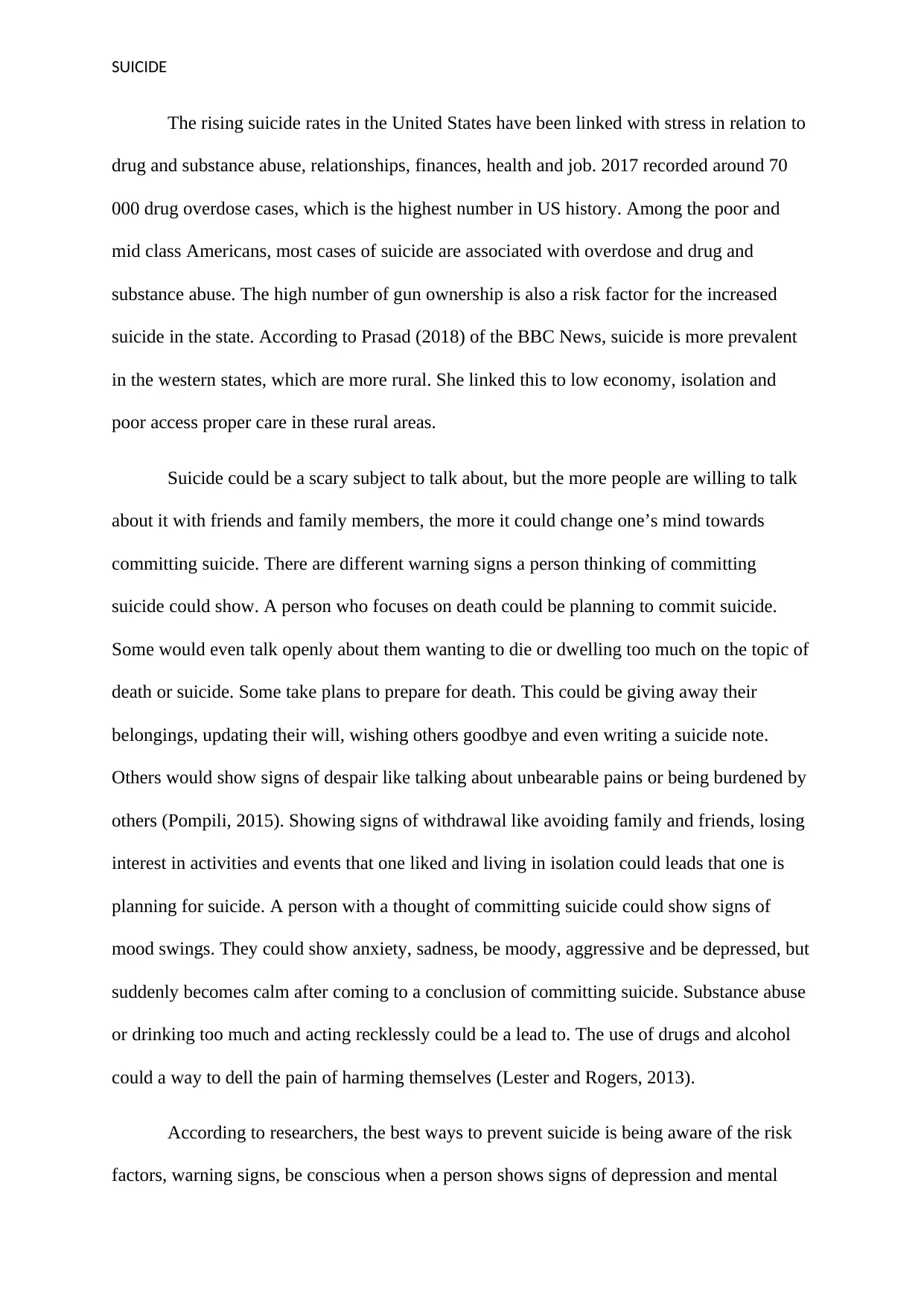
SUICIDE
The rising suicide rates in the United States have been linked with stress in relation to
drug and substance abuse, relationships, finances, health and job. 2017 recorded around 70
000 drug overdose cases, which is the highest number in US history. Among the poor and
mid class Americans, most cases of suicide are associated with overdose and drug and
substance abuse. The high number of gun ownership is also a risk factor for the increased
suicide in the state. According to Prasad (2018) of the BBC News, suicide is more prevalent
in the western states, which are more rural. She linked this to low economy, isolation and
poor access proper care in these rural areas.
Suicide could be a scary subject to talk about, but the more people are willing to talk
about it with friends and family members, the more it could change one’s mind towards
committing suicide. There are different warning signs a person thinking of committing
suicide could show. A person who focuses on death could be planning to commit suicide.
Some would even talk openly about them wanting to die or dwelling too much on the topic of
death or suicide. Some take plans to prepare for death. This could be giving away their
belongings, updating their will, wishing others goodbye and even writing a suicide note.
Others would show signs of despair like talking about unbearable pains or being burdened by
others (Pompili, 2015). Showing signs of withdrawal like avoiding family and friends, losing
interest in activities and events that one liked and living in isolation could leads that one is
planning for suicide. A person with a thought of committing suicide could show signs of
mood swings. They could show anxiety, sadness, be moody, aggressive and be depressed, but
suddenly becomes calm after coming to a conclusion of committing suicide. Substance abuse
or drinking too much and acting recklessly could be a lead to. The use of drugs and alcohol
could a way to dell the pain of harming themselves (Lester and Rogers, 2013).
According to researchers, the best ways to prevent suicide is being aware of the risk
factors, warning signs, be conscious when a person shows signs of depression and mental
The rising suicide rates in the United States have been linked with stress in relation to
drug and substance abuse, relationships, finances, health and job. 2017 recorded around 70
000 drug overdose cases, which is the highest number in US history. Among the poor and
mid class Americans, most cases of suicide are associated with overdose and drug and
substance abuse. The high number of gun ownership is also a risk factor for the increased
suicide in the state. According to Prasad (2018) of the BBC News, suicide is more prevalent
in the western states, which are more rural. She linked this to low economy, isolation and
poor access proper care in these rural areas.
Suicide could be a scary subject to talk about, but the more people are willing to talk
about it with friends and family members, the more it could change one’s mind towards
committing suicide. There are different warning signs a person thinking of committing
suicide could show. A person who focuses on death could be planning to commit suicide.
Some would even talk openly about them wanting to die or dwelling too much on the topic of
death or suicide. Some take plans to prepare for death. This could be giving away their
belongings, updating their will, wishing others goodbye and even writing a suicide note.
Others would show signs of despair like talking about unbearable pains or being burdened by
others (Pompili, 2015). Showing signs of withdrawal like avoiding family and friends, losing
interest in activities and events that one liked and living in isolation could leads that one is
planning for suicide. A person with a thought of committing suicide could show signs of
mood swings. They could show anxiety, sadness, be moody, aggressive and be depressed, but
suddenly becomes calm after coming to a conclusion of committing suicide. Substance abuse
or drinking too much and acting recklessly could be a lead to. The use of drugs and alcohol
could a way to dell the pain of harming themselves (Lester and Rogers, 2013).
According to researchers, the best ways to prevent suicide is being aware of the risk
factors, warning signs, be conscious when a person shows signs of depression and mental
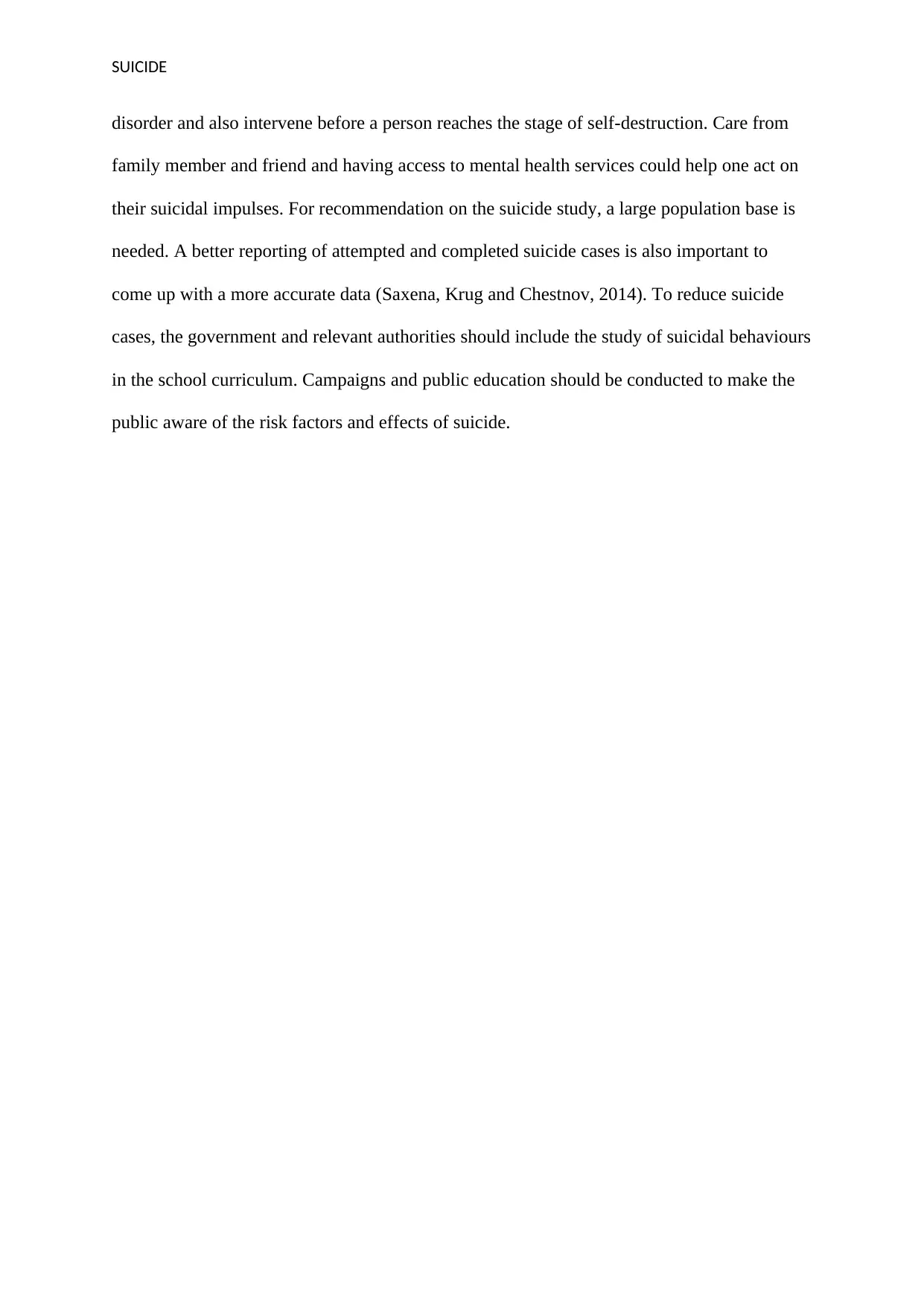
SUICIDE
disorder and also intervene before a person reaches the stage of self-destruction. Care from
family member and friend and having access to mental health services could help one act on
their suicidal impulses. For recommendation on the suicide study, a large population base is
needed. A better reporting of attempted and completed suicide cases is also important to
come up with a more accurate data (Saxena, Krug and Chestnov, 2014). To reduce suicide
cases, the government and relevant authorities should include the study of suicidal behaviours
in the school curriculum. Campaigns and public education should be conducted to make the
public aware of the risk factors and effects of suicide.
disorder and also intervene before a person reaches the stage of self-destruction. Care from
family member and friend and having access to mental health services could help one act on
their suicidal impulses. For recommendation on the suicide study, a large population base is
needed. A better reporting of attempted and completed suicide cases is also important to
come up with a more accurate data (Saxena, Krug and Chestnov, 2014). To reduce suicide
cases, the government and relevant authorities should include the study of suicidal behaviours
in the school curriculum. Campaigns and public education should be conducted to make the
public aware of the risk factors and effects of suicide.
⊘ This is a preview!⊘
Do you want full access?
Subscribe today to unlock all pages.

Trusted by 1+ million students worldwide
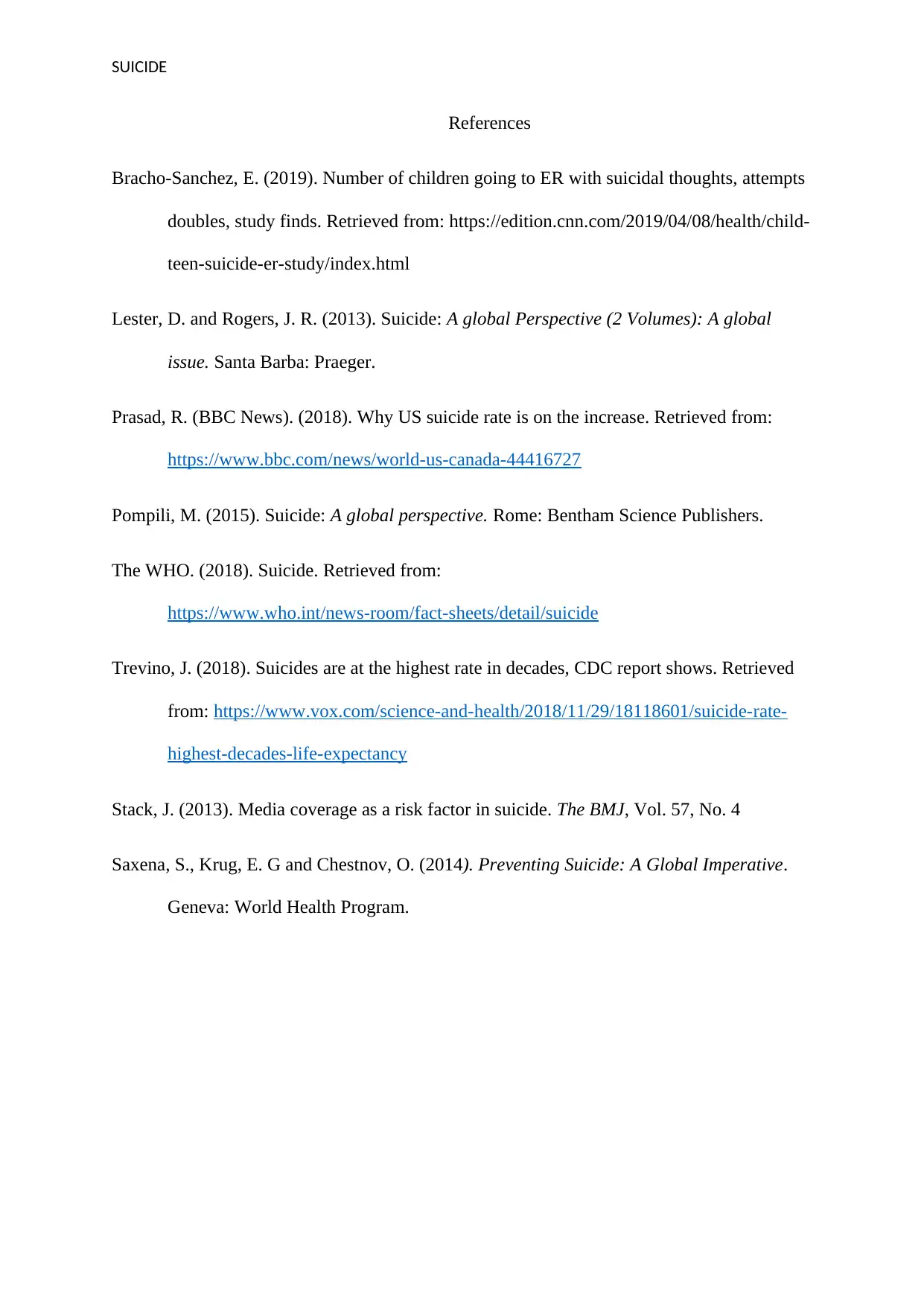
SUICIDE
References
Bracho-Sanchez, E. (2019). Number of children going to ER with suicidal thoughts, attempts
doubles, study finds. Retrieved from: https://edition.cnn.com/2019/04/08/health/child-
teen-suicide-er-study/index.html
Lester, D. and Rogers, J. R. (2013). Suicide: A global Perspective (2 Volumes): A global
issue. Santa Barba: Praeger.
Prasad, R. (BBC News). (2018). Why US suicide rate is on the increase. Retrieved from:
https://www.bbc.com/news/world-us-canada-44416727
Pompili, M. (2015). Suicide: A global perspective. Rome: Bentham Science Publishers.
The WHO. (2018). Suicide. Retrieved from:
https://www.who.int/news-room/fact-sheets/detail/suicide
Trevino, J. (2018). Suicides are at the highest rate in decades, CDC report shows. Retrieved
from: https://www.vox.com/science-and-health/2018/11/29/18118601/suicide-rate-
highest-decades-life-expectancy
Stack, J. (2013). Media coverage as a risk factor in suicide. The BMJ, Vol. 57, No. 4
Saxena, S., Krug, E. G and Chestnov, O. (2014). Preventing Suicide: A Global Imperative.
Geneva: World Health Program.
References
Bracho-Sanchez, E. (2019). Number of children going to ER with suicidal thoughts, attempts
doubles, study finds. Retrieved from: https://edition.cnn.com/2019/04/08/health/child-
teen-suicide-er-study/index.html
Lester, D. and Rogers, J. R. (2013). Suicide: A global Perspective (2 Volumes): A global
issue. Santa Barba: Praeger.
Prasad, R. (BBC News). (2018). Why US suicide rate is on the increase. Retrieved from:
https://www.bbc.com/news/world-us-canada-44416727
Pompili, M. (2015). Suicide: A global perspective. Rome: Bentham Science Publishers.
The WHO. (2018). Suicide. Retrieved from:
https://www.who.int/news-room/fact-sheets/detail/suicide
Trevino, J. (2018). Suicides are at the highest rate in decades, CDC report shows. Retrieved
from: https://www.vox.com/science-and-health/2018/11/29/18118601/suicide-rate-
highest-decades-life-expectancy
Stack, J. (2013). Media coverage as a risk factor in suicide. The BMJ, Vol. 57, No. 4
Saxena, S., Krug, E. G and Chestnov, O. (2014). Preventing Suicide: A Global Imperative.
Geneva: World Health Program.
1 out of 7
Related Documents
Your All-in-One AI-Powered Toolkit for Academic Success.
+13062052269
info@desklib.com
Available 24*7 on WhatsApp / Email
![[object Object]](/_next/static/media/star-bottom.7253800d.svg)
Unlock your academic potential
Copyright © 2020–2025 A2Z Services. All Rights Reserved. Developed and managed by ZUCOL.





